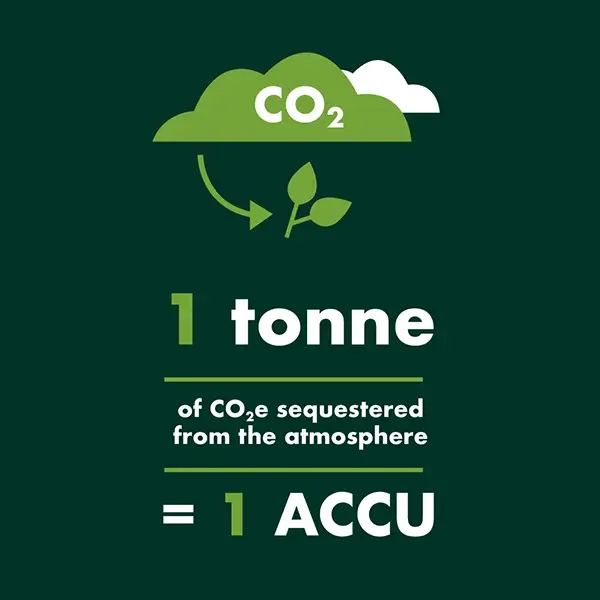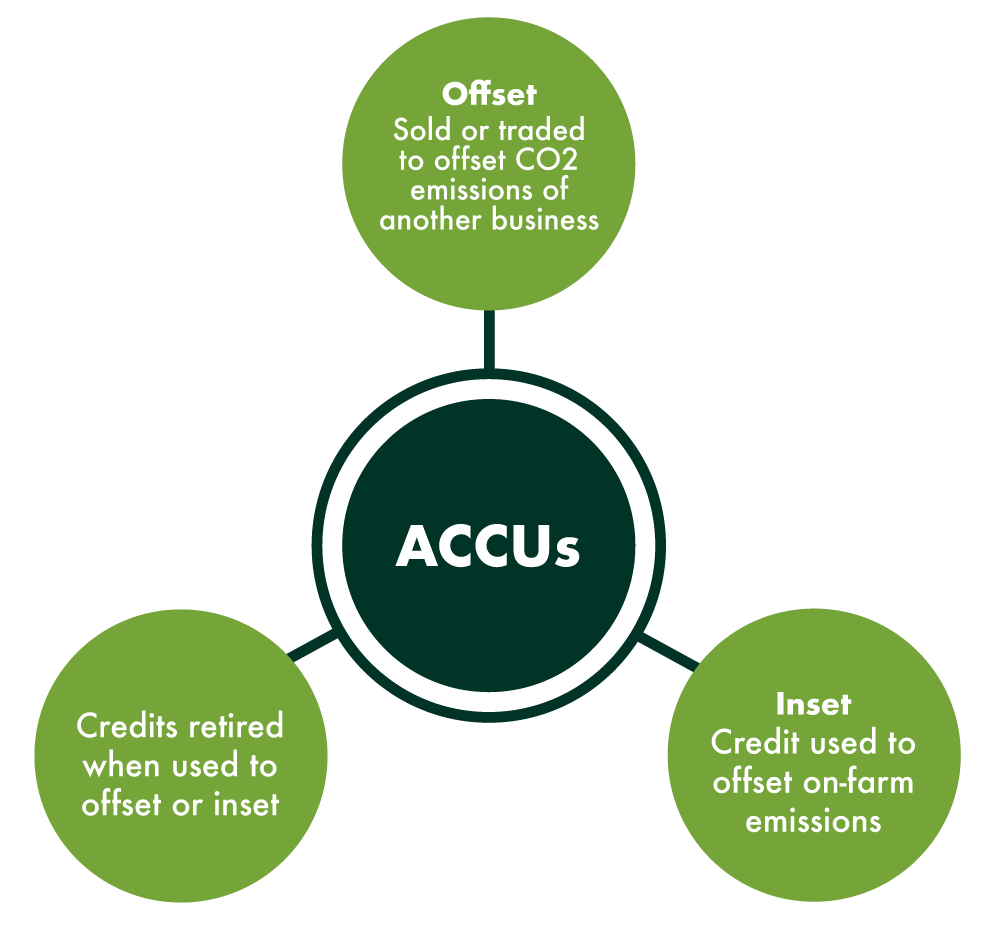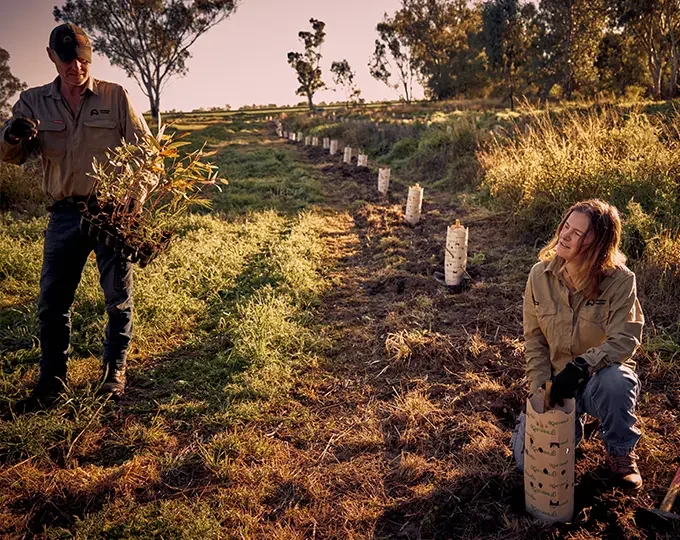OVERVIEW
Thinking about Carbon Farming or Nature Repair? Let’s explore the options.
This information is aimed at eligible Australian landholders and farmers wanting to learn more about environmental markets.
We will break down the Carbon Market (ACCU Scheme), explain key concepts like newness and permanence obligations for generating ACCUs. Plus, we’ll introduce you to the new Nature Repair Market and the simple steps to participate. Discover how you might even stack projects with the ACCU Scheme, finding common ground in project planning across both.
DISCLAIMER: This general information has been prepared by Landcare Australia (AR 1315198 of Australian Carbon Traders Pty Ltd AFSL 425512) for farmers and landholders who are eligible to be treated as wholesale clients. It does not take into account your objectives, needs or situation. ACCUs and derivatives are financial products. While we have outlined common benefits, risks and constraints here, we strongly recommend you seek independent financial and legal advice before acting on any decision to invest. Click here for further regulatory information.
The Carbon market (ACCU Scheme)
What is the ACCU Scheme?
The Australian Carbon Credit Unit (ACCU) Scheme is a voluntary scheme that incentivises individuals and businesses to change practices to reduce carbon emissions or store carbon.
Landowners who undertake a project under an ACCU Scheme method can earn carbon credits (ACCUs). The scheme is administered and regulated by the Clean Energy Regulator (CER) through the Carbon Credits (Carbon Farming Initiative) Act 2011 (CFI Act 2011) and the Carbon Credits (Carbon Farming Initiative) Rule 2015 (CFI Rule 2015).
Several methods are available under the ACCU Scheme which specify activities farmers can implement to earn ACCUs. Many methods align with on-farm operations and specific requirements of industry bodies (e.g. Meat and Livestock Australia).

How do you engage in the carbon market?
There are two parts to engaging in the carbon market:
- Registering and running a project under an approved methodology to earn ACCUs.
- Selling ACCUs to the Australian Government or other market/entity (e.g. a corporate business). Or using generated carbon credits to inset emissions from your property.
Carbon abatement projects involving the removal of carbon dioxide from the atmosphere by storage of carbon in plants are referred to as vegetation method projects. Vegetation methods that involve the planting of trees include the Reforestation by Environmental or Mallee Plantings method 2024 (herein referred to as ‘Environmental Planting project/s’ for the purposes of this Toolkit). This Toolkit will focus exclusively on this method.

Generating ACCUs
The ACCU Scheme has several key criteria that projects must meet to be eligible:

1. Newness
Projects must be new and not already implemented before registration. Projects must demonstrate that they result in carbon abatement that would not have occurred without the scheme. Learn how newness is assessed.

2. Permanence
Projects must ensure that carbon storage is maintained for a specified period, typically 25 or 100 years. Learn more about permanence obligations.

3. Methodology Compliance
Projects must follow the approved methodology that outlines the specific activities, measurement, monitoring, and reporting requirements.

4. Legal Right
Participants must have the legal right to carry out the project activities on the land or property involved.

5. Regulatory Compliance
Projects must comply with all relevant local, state, and federal regulations.
The Nature Repair Market
What is the Nature Repair Market?
The Nature Repair Market scheme is an Australian Government initiative that provides a framework to restore and protect the environment. It encourages land management practices that deliver improved biodiversity outcomes for Australia.
Individuals and organisations who run successful projects can apply for a biodiversity certificate. One certificate is issued per project.
This certificate can be:
- sold to a range of buyers to generate income
- held by the owner
- deposited with the Clean Energy Regulator.

What is the Nature Repair Methodology?
Individuals and organisations that invest in a project or hold a biodiversity certificate can make public statements or ‘claims’ about biodiversity outcomes being delivered by the project.
The first approved method is the Nature Repair (Replanting Native Forest and Woodland Ecosystems) Methodology Determination 2025. This method is designed to enhance or protect biodiversity in native species by replanting native forest and woodland ecosystems on historically cleared land landscapes that will improve native vegetation or support ecological connectivity.
The method specifies:
- the planting activities to be carried out
- engagement with relevant Aboriginal persons or Torres Strait Islanders
- how you measure biodiversity
- monitoring, record keeping and reporting requirements.
You must run your project in accordance with the method.

What are the steps to participate in the Nature Repair Market?


1. Check eligibility and scheme requirements
Review the method requirements and the Nature Repair Market scheme requirements on the CER website to determine project eligibility. You can also visit the Platform for Land and Nature Repair (PLANR), which is an online tool to support landholders to participate in the scheme.
If your project area is subject to Indigenous land interests, you must engage appropriately with the relevant Indigenous representatives on the design and implementation of the project.
2. Undertake a starting state assessment and develop a project plan.
A starting state assessment and project plan undertaken by a suitably qualified person will determine:
- The starting ecosystem condition state of the land
- The reference ecosystem to be restored
- The restoration target level to be achieved from the planting.
For projects nominating to enhance a culturally significant entity, the starting state assessment must include this information. Culturally significant entities are a thing, place, matter or process within the project area that has cultural significance to relevant Aboriginal persons or Torres Strait Islanders (for example, a totem species, significant tree or ecosystem or meeting place).
3. Register the project
Submit the application to register a project with the CER. The CER will assess the application to verify that the project meets requirements. Once registered it will be published on the Biodiversity Market Register.
4. Establish and maintain project
Following registration, you must ensure the project is implemented as per the project plan. The method defines activities which can be completed and those which are prohibited (e.g. vegetation removal).
5. Monitor and report
You will need to monitor the project and submit biodiversity project reports to demonstrate that the project is on track. A report must be submitted at least every 5 years.
There are additional steps to be able to complete a project including legal right, landholder consent, regulatory approvals and native title area consent. For more information on participating in the Nature Repair market method, see the Replanting Native Forest and Woodland Ecosystems Information Pack.
Stacking with the ACCU scheme
What is stacking?
A stacked project refers to a two or more projects being undertaken on the same, or partially overlapping, areas of land that are being rewarded for different outcomes.
A project being rewarded under the ACCU scheme for the carbon sequestered in woody vegetation and debris can also be rewarded under the Nature Repair Market scheme for the biodiversity outcome from improvement in the extent and condition of native vegetation.
If you wish to register a stacked project under both the ACCU Scheme and Nature Repair Market scheme, you must submit 2 separate applications to the CER. This is necessary to comply with the separate legislative requirements under each scheme. There may be opportunities to design a planting project that meets the requirements under Reforestation by Environmental and Mallee Plantings – FullCAM 2024 method and the Nature Repair (Replanting Native Forest and Woodland Ecosystems) Methodology Determination 2025.
Make sure you understand ACCU scheme and Nature Repair Market scheme eligibility requirements before starting your planting activities to ensure you can participate in both schemes for the same plantings. In particular:
- to meet the ‘newness’ test under the ACCU scheme, your ACCU project registration application must be submitted first
- if you have already started planting trees for a biodiversity project, but you haven’t registered your ACCU project, you will not be able to claim the carbon benefit from the plantings.
Areas of alignment
You can undertake common activities that will support project planning for both the ACCU scheme and Nature Repair Market scheme including:
- Planning, designing or determining the feasibility of the project
- Obtaining consents or regulatory approval to conduct the project (noting these requirements may differ across the schemes)
- Engaging experts to support both carbon and biodiversity aspects of the project
- Align the submission of Offsets reports under the ACCU Scheme and biodiversity project reports to support efficiencies.
- Engaging a single auditor to cover requirements of both schemes at the same time, where possible.